
Looking ahead to the Global Fund Strategy in Grant Cycle 7 Part III
Author:
Amida Kariburyo
Article Type:Article Number: 8
Mutually reinforcing contributory and evolving objectives: Health Financing, including NextGen Market Shaping
This third article in the series on Looking ahead to Grant Cycle 7 – Strategy examines the Strategy’s “Mutually reinforcing contributory and evolving objectives” from the viewpoint of Health Financing and NextGen Market Shaping. It looks at how the Strategy has been implemented in Grant Cycle 7 funding proposals and future implications, including the challenges ahead and efforts needed to address these concerns.
Our third and final article in this series examines how health financing and related areas have been reflected in Grant Cycle 7 (GC7) funding requests (FRs). It highlights elements of health finance levers – however, as a mutually reinforcing objective of the Global Fund Strategy 2023-2028, core inputs and results are, by definition, integrated across HIV, TB and malaria (HTM).
Health Finance
Macro challenges likely to affect financing for health, creating challenges for domestic financing for health and national responses during GC7 and beyond
Figure 1. Macro challenges affecting domestic health financing
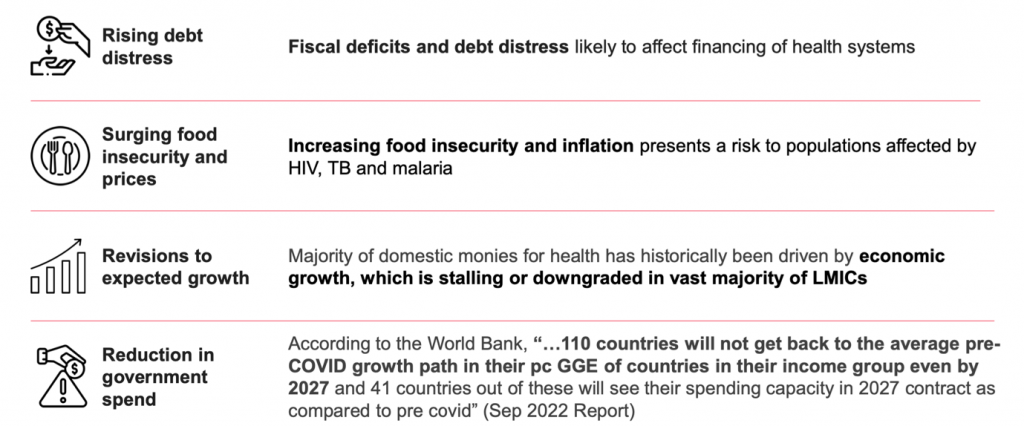
This reduction in government spend is expected to have lasting effects on the health sector. Consequently, these external pressures are likely to impact key performance indicators (KPI) execution, necessitating ongoing efforts in Public Financial Management (PFM), and signaling the need for a reset in domestic funding KPIs, particularly given the evolving economic landscape.
Figure 2. PFM, domestic resource mobilization and allocations for Human Rights and KPs
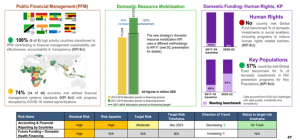
Supporting countries throughout GC7 to strengthen financial sustainability and improve health outcomes will require a multipronged approach
Figure 3. Multifaceted approach to support countries’ financial sustainability and improved health outcomes

To strengthen outcomes, the Secretariat has worked to align co-financing requirements to the fiscal context facing countries and updated the KPIs to ensure performance insight.
Figure 4. Determining co-financing potential and updating KPIs in GC7
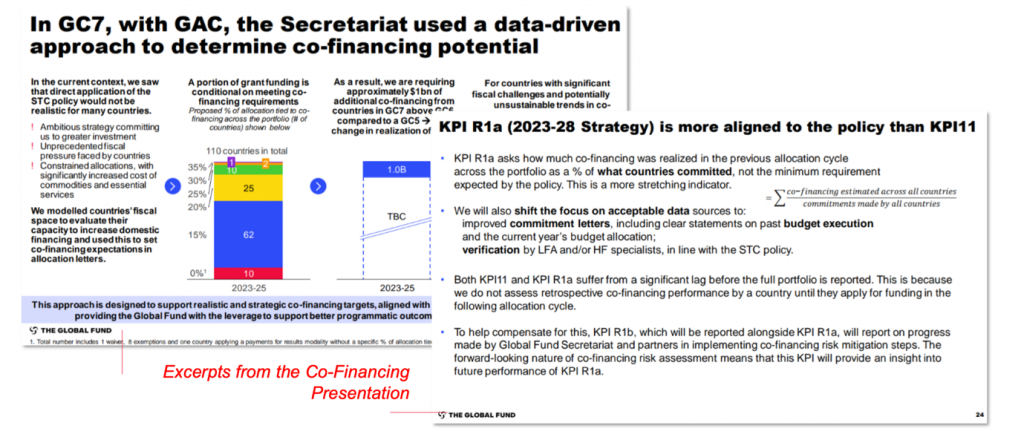
Preliminary analysis of GC7 demonstrates more rigor, consistency and quality of co-financing commitments
The figure below shows how, as of October 2023, there were early signals that the GC7 potential was well-targeted regarding co-financing. This was undoubtedly facilitated by operational improvements: a consistent approach to assessing compliance and data requirements; the Mandatory Commitment Letter for GC7 requiring all countries to include financial and programmatic commitments; and more support for health financing data governance, and tracking programmatic commitments and risk. By 23 October, over 15 countries had gone through the Grants Approval Committee (GAC) review for GC7:
Figure 5. Early insights from GC7 on co-financing outcomes
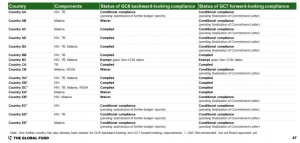
Public Financing Management
Efforts to strengthen PFM are underway.
Figure 6. Secretariat interventions regarding PFM
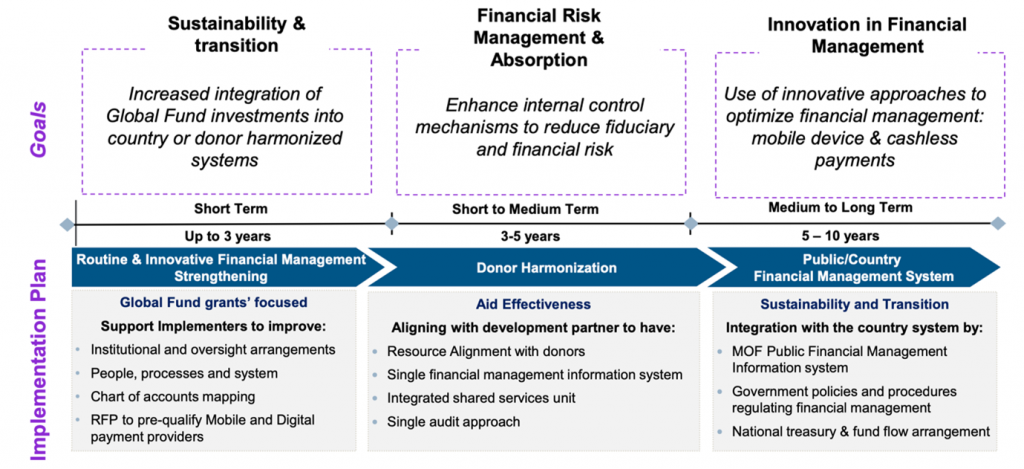
Figure 7. Achievements and focus of ongoing efforts demonstrate growing opportunity in PFM
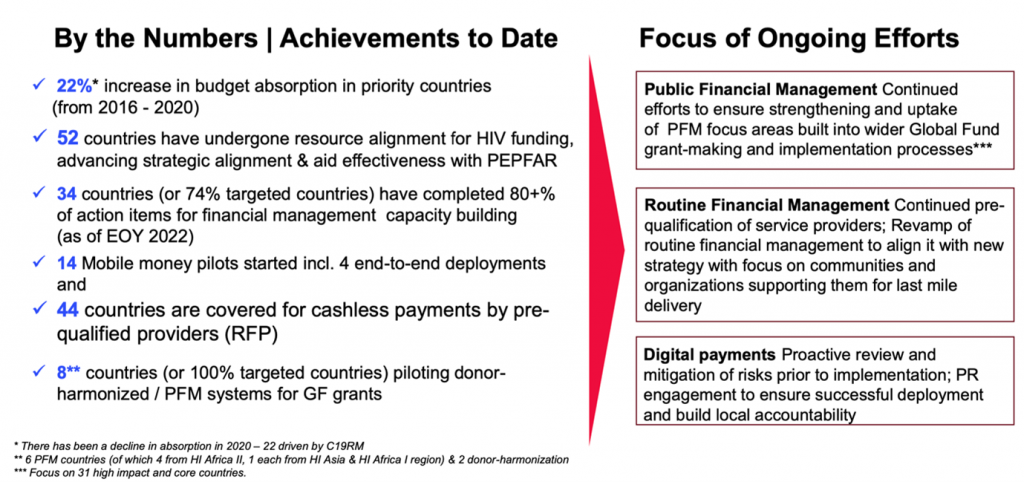
Using innovative new tools to turn the dial for more resources to support HTM and RSSH
As the Global Fund moves through GC7 and beyond, leveraging new tools – including blended finance – is essential to raise additional, and influence existing, resources to support HTM and RSSH objectives. Another mechanism is combining Global Fund grants with investments from multilateral development banks/finance institutions to encourage new financing or influence existing financing in support of HTM and RSSH objectives. These can complement Global Fund grants to achieve strategic, programmatic, and operational priorities:
Figure 8. Mechanisms to achieve strategic, programmatic and operational imperatives
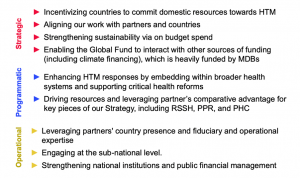
Country examples
Some examples of how the Global Fund and investment partners have strengthened impact in GC7:
- India and Indonesia Loan Buy Downs incentivized additional domestic financing in two TB contexts, by encouraging and supporting Ministries of Finance to borrow for the health sector and TB control efforts and undertake critical health reforms.
- Pakistan: A joint investment designed to promote TB notification and case finding as well as strengthen primary health care/universal health coverage (PHC/UHC).
- Additional Transactions to support migrant populations to access antiretroviral therapy (ART) through social health insurance in one upper-middle-income (UMI) country and embed malaria community level interventions in national purchasing mechanisms.
The Global Fund is making major strides across health financing levers to catalyze resources: and can go further with strong partnerships
The Global Fund is committed to sustainability – in the current micro fiscal situation/context with budgetary pressures, it is laying stronger foundations to sustain the responses and continue to deliver.
The broader partnership can be a game changer in the following ways:
- Keeping health prioritized among heads of state and the African Union.
- Ensuring pragmatic operationalization of co-financing in the post-COVID context; credible and realistic partnership with countries.
- Innovating with multilateral development banks (MDBs) to leverage and increase concessional financing and crowd-in resources to achieve Sustainable Development Goal 3.
- Working together with partners and governments on financial sustainability planning country-by-country
NextGen Market Shaping and Pooled Procurement Mechanism (PPM)/Wambo.org
Aims and focus of NextGen Market Shaping
The NextGen Market Shaping approach is designed to drive equitable access to quality assured health products and foster innovation with a focus on
- Accelerating scaled introduction of new tools and innovations for better outcomes and impact.
- Promoting regional supply base diversification for improved supply security.
- Supporting sustainable procurement and supply chains to ensure responsiveness and efficiency gains.
It builds on critical foundational interventions for robust and resilient national and community health systems: in-country capacity building, regulatory framework strengthening, and market surveillance. The approach aims to serve as a collaboration platform to harness partnership-wide engagement to advance prioritized efforts, focusing on complementarity and accelerating progress. Drawing on lessons from the COVID-19 pandemic, there is increasing focus on the impacts of climate change. There is particular focus on introduction of new products, and when there is an imbalance and/or misalignment between demand and supply or geographic footprint that could result in limited availability, long lead-times, higher costs.
NextGen Market Shaping efforts underpin the delivery of an important component of UHC: equitable access to life-saving medicines and health tools.
Figure 9. NextGen Market Shaping framework
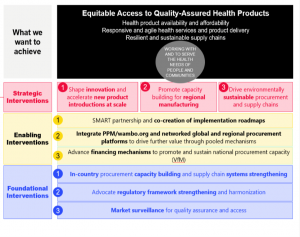
Improved access to quality assured health products for GC7 and beyond
Progress to date
- Established Revolving Facility to accelerate health product introductions at scale. Secured supply capacity at lower access prices for accelerated introduction of CFP Dual active ingredient (AI) nets (>45% more effective) to address biological threats to malaria.
- With partners, achieved lower sustainable pricing contributing to more equitable access to affordable quality assured health products: (a) lower costs for first-line antiretroviral drugs (ARVs) treatment TLD to below $45 per person per year; and (b) breakthrough pricing reduction on TB treatment (including a 55% reduction in cost of Bedaquilin for MDR-TB) and diagnostics (20% price reduction for GeneXpert TB cartridges), as well as improved care for equipment service and maintenance.
- Accelerating capacity building for regional manufacturing and procurement of rapid diagnostics. Expert Review Panel-Diagnostics (ERP-D) call for proposals launched for HIV rapid diagnostic tests (RDTs) manufactured in Africa.
- On track to finalize the NextGen Market Shaping Strategic Initiative investment plan for approval by the Grants Approval Committee (GAC) by end 2023.
- Reviewed and updated existing Quality Assurance (QA) Policies. The Strategy Committee recommended two QA Policies for Board decision in November.
Partner engagement
The Global Fund is:
- Leveraging the Global Fund-Unitaid Task Force for wider collaboration to accelerate HTM innovation and product introduction.
- Engaging with technical partners and donors through disease situation rooms to prioritize and align market shaping approach for accelerated health product introductions.
- Dialoguing with the World Health Organization and the United States Government (USG) through PEPFAR to drive accelerated and streamlined regulatory pathways to enable regional manufacturing capacity building and procurement and new product introductions.
- Developing interventions for capacity building for regional manufacturing and procurement with key partners including the African Constituency Bureau, GIZ, USG and several regional economic communities in Africa.
- Developing an aligned approach to strengthen country capacity for procurement and supply chains focusing on digitization, data interoperability, last mile distribution, including assessing opportunities for environmentally sustainable solutions.
Looking ahead to the biggest challenges and actions
Outstanding challenges
- NextGen implementation is impacted by geopolitical uncertainties and economic challenges affecting global supply chains, which include inflationary trends and fluctuations in commodity pricing.
- Constrained resources for all NextGen priorities in GC7 lead to competing priorities, compelling countries to make challenging trade-off decisions, particularly in areas like malaria control.
- Effective change management is necessary at various levels, including the country, Secretariat, and governance, to implement new and scaled interventions such as the Revolving Facility, new health product introductions, and policies.
- Managing stakeholder expectations is crucial due to the complexity of the work required across the partner ecosystem and countries.
Actions for key stakeholders
Countries: Sustain strong collaboration and coordination with Global Fund Country Teams for the optimal execution of GC7, emphasizing innovation and extended coverage.
Secretariat: Persist in utilizing the NextGen Market Shaping approach to narrow the gap toward achieving 2030 goals, actively contributing to PPR, addressing the climate and health agenda, and incorporating the future of global health initiatives (FGHI) considerations.
Larger partnership considerations: Maintain ongoing engagement to align on common priorities, emphasizing a streamlined and complementary approach to interventions for maximum outcomes and impact.
Looking ahead together at GC7 and beyond
Early indicators suggest that GC7 is well-positioned to maintain advancements and progress in crucial areas by prioritizing strategically-focused Health Technology and Manufacturing programs aligned with the Strategy’s objectives. The increase in the reach of prevention, testing, and treatment services, facilitated by commodity price reductions and robust markets, is noteworthy. Strengthened community engagement, along with a central emphasis on human rights, health equity, and gender equality, is proving vital in extending program reach, resilience, and quality within the challenging global context. Moreover, enhanced and comprehensive RSSH-PPR investments are strategically positioned to bolster system resilience in addressing HTM and broader pandemic threats.
However, the Global Fund and its partnership are confronting an imminent threat to the achievement of their mission. Challenges include overall HTM funding falling significantly below the levels necessary to meet SDGs, escalating discrimination, shrinking civic space, fiscal constraints limiting government health spending, and multi-crises involving human rights, climate, and conflict. Moreover, the shift in global and donor priorities away from HTM and health poses a severe risk of disease resurgence. Without sustained and increased partnership attention and resources, there is a genuine risk of losing and reversing gains, reducing treatment scale-up, increasing infections, and expanding drug resistance, thus limiting the efficacy of existing tools. Addressing these challenges is crucial to safeguarding progress and achieving long-term success.
******
Board paper GF/B50/08 Strategy Implementation: Acceleration into Grant Cycle 7 will soon be available on the Global Fund website.
